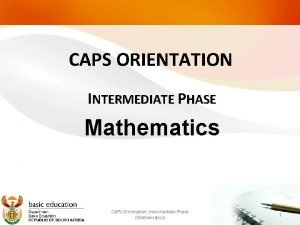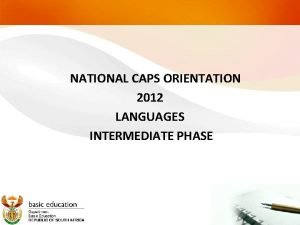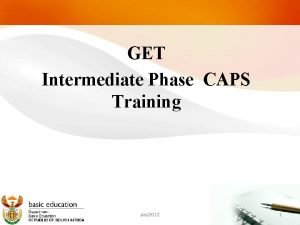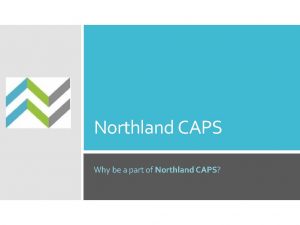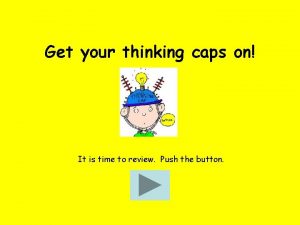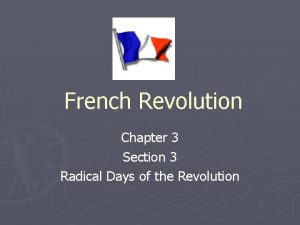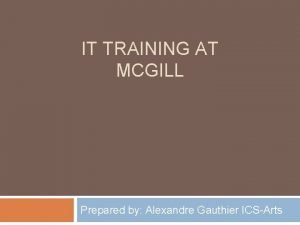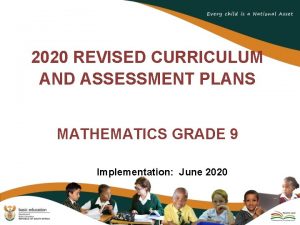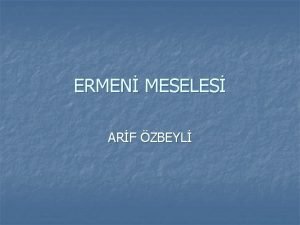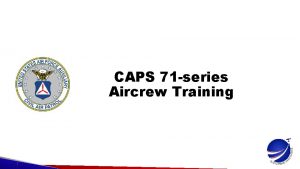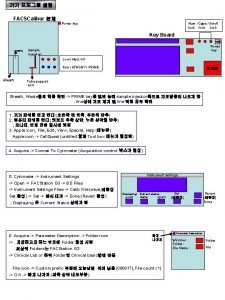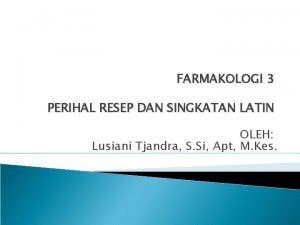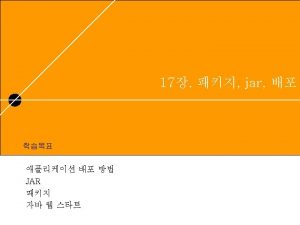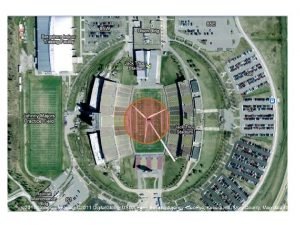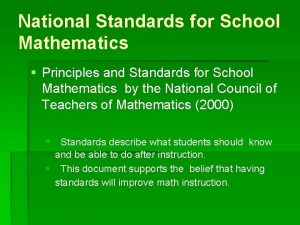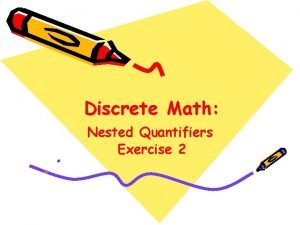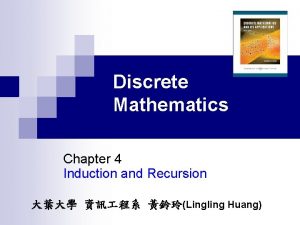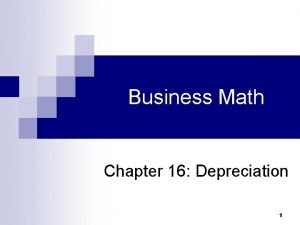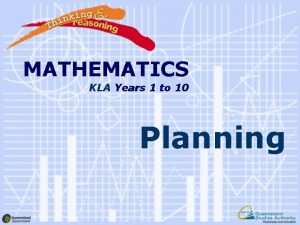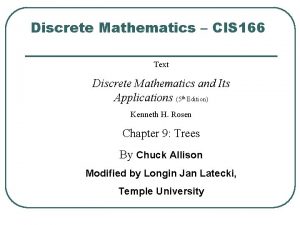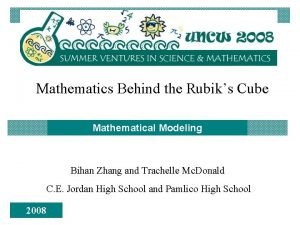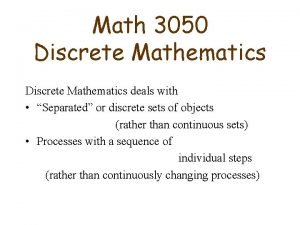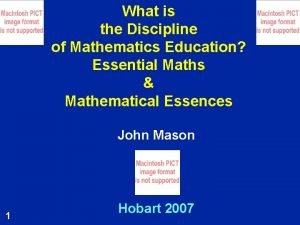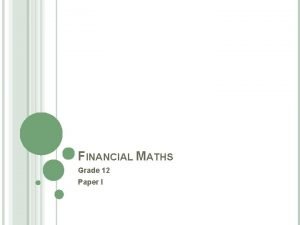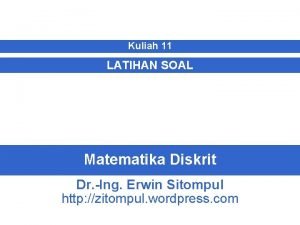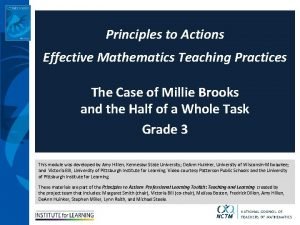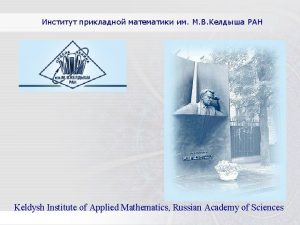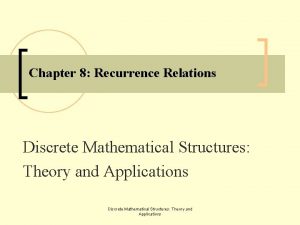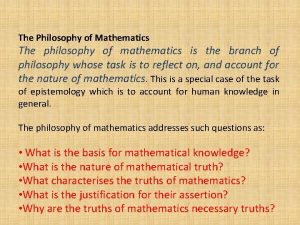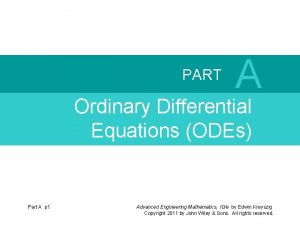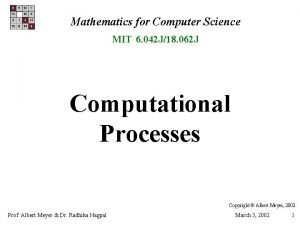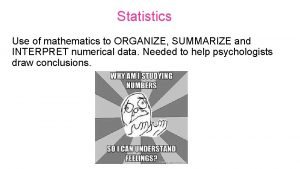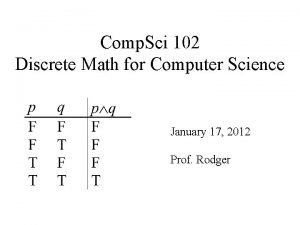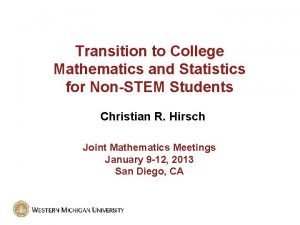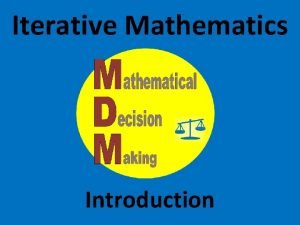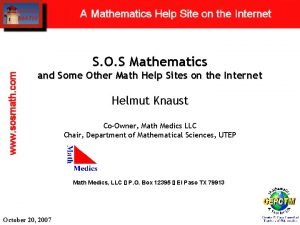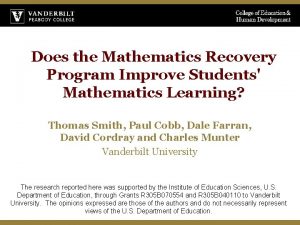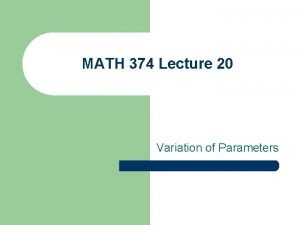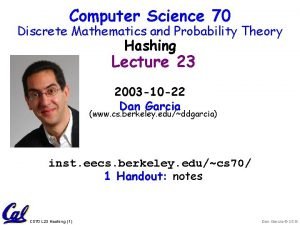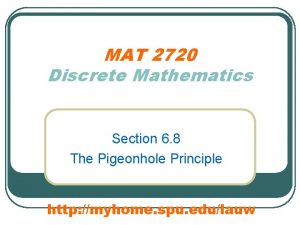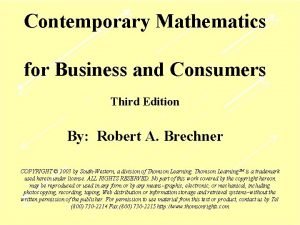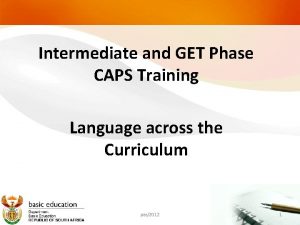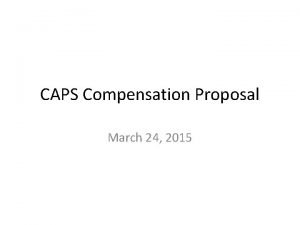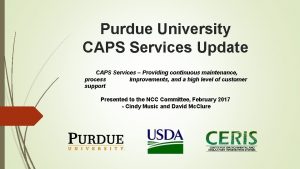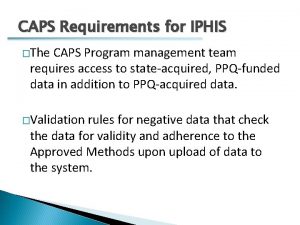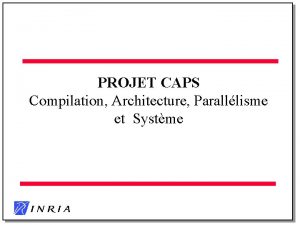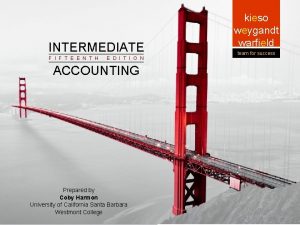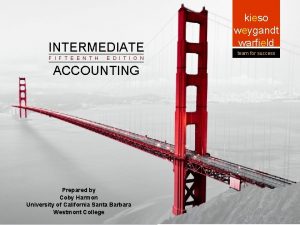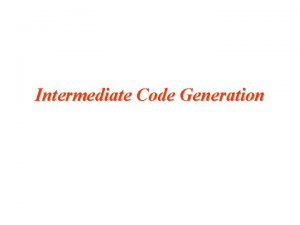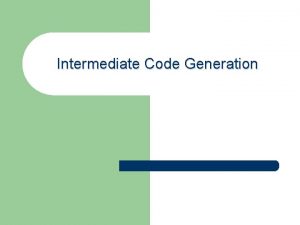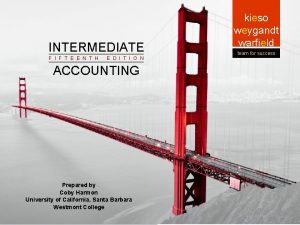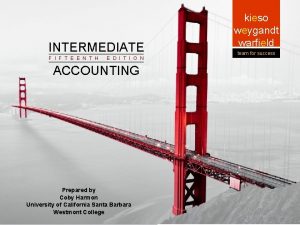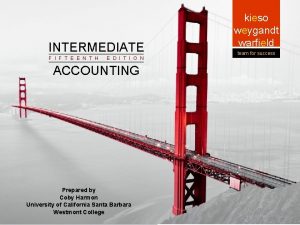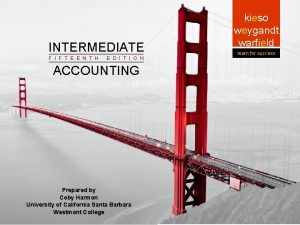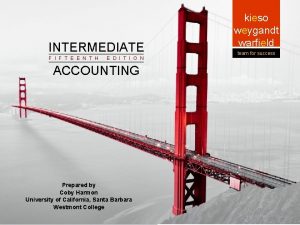CAPS ORIENTATION INTERMEDIATE PHASE Mathematics CAPS Orientation Intermediate



















































































- Slides: 83

CAPS ORIENTATION INTERMEDIATE PHASE Mathematics CAPS Orientation: Intermediate Phase (Mathematics) 1

2. 1 Outcomes At the end of the activity participants should be able to: unpack the definition of mathematics highlight the implications of the definition for teaching, learning and assessment. CAPS Orientation: Intermediate Phase (Mathematics) 2

Definition of Mathematics • Is a language that makes use of symbols and notations • Describes numerical, geometric and graphical relationships. • A human activity that involves observing, representing and investigating patterns • Quantitative relationships in physical and social phenomena • It helps to develop mental processes • Enhance logical and critical thinking, accuracy and problem solving that will contribute in decision making. CAPS Orientation: Intermediate Phase (Mathematics) 3

2. 1 Definition of Mathematics • A passage that explains the meaning of Mathematics • A statement of the essence of Mathematics – The attribute or set of attributes that makes Mathematics what it fundamentally is, – Which it has by necessity, – Without which it looses its identity. CAPS Orientation: Intermediate Phase (Mathematics) 4

2. 1 Activity questions 2. 1. 1 Examine the definition of mathematics provided in Excerpt 1 on page 8 of CAPS and identify the key elements thereof; 2. 1. 2 Briefly discuss practical implications of the definition of Mathematics for: • teaching; • learning; and • assessment CAPS Orientation: Intermediate Phase (Mathematics) 5

2. 1 Possible responses: 2. 1. 1 Key elements of the definition of Mathematics as a language – symbols and notations Mathematics as human activity i. e. we learn mathematics by doing mathematics; mathematics is dynamic i. e. evolves over time. Development of mental processes – logical and critical thinking, accuracy and problem solving, procedural fluency. CAPS Orientation: Intermediate Phase (Mathematics) 6

2. 1. 2 Possible responses… Teaching: teachers should use correct mathematical language including symbols and notation teach mathematical language must be taught in context teachers should use appropriate teaching approaches that are mainly learner-centred (to be discussed in detail in Section 3) CAPS Orientation: Intermediate Phase (Mathematics) 7

2. 1. 2 Possible responses Learning: mastery of correct mathematical language by learners is key as it enhances conceptual understanding, procedural fluency and strategic competence. active participation of learners enhances mental processes required for logical and critical thinking. problem solvers. CAPS Orientation: Intermediate Phase (Mathematics) 8

Possible responses Assessment: Assessment should: promote the correct use of mathematical language encourage logical and critical thinking be realistic and authentic (to be discussed in detail in Section 4) Use different forms of assessment to respond to elements such as representing, investigating, problem solving as well as issues of diversity CAPS Orientation: Intermediate Phase (Mathematics) 9

2. 2 Understanding aims and skills Other than the definition of Mathematics, the aims and skills • are as important as the content. • are presented on page 8 of the CAPS document. CAPS Orientation: Intermediate Phase (Mathematics) 10

2. 2 Outcomes At the end of the activity participants should be able to: • understand the aims and skills of Mathematics in the Intermediate Phase. • use practical examples drawn from Section 2 of CAPS (any grade), where possible, to show the implications of aims and skills for teaching, learning and assessment. CAPS Orientation: Intermediate Phase (Mathematics) 11

2. 2 Activity question Use examples drawn from the CAPS, where possible, to demonstrate your understanding of the aims and skills of Mathematics in the Intermediate Phase. Limit your discussion to the teaching, learning and assessment of Mathematics. CAPS Orientation: Intermediate Phase (Mathematics) 12

2. 2 Possible responses AIMS: a critical awareness of how mathematical relationships are used in social, environmental, cultural and economic relations Teaching Teach mathematics in context where possible. (e. g. Number sentences) Learning Apply mathematics in social, environment, cultural and economic context Assessment Should cover variety of contexts CAPS Orientation: Intermediate Phase (Mathematics) 13

2. 2 cont. / SKILL: correct use of the language of Mathematics Teaching Communicate mathematically and encourage the use of mathematics dictionary or glossary of terminology. Example start from simple concept such as sharing then move on to divide Learning Communicate mathematically; use mathematics dictionary or glossary of terminology Assessment Correct mathematical language in assessment CAPS Orientation: Intermediate Phase (Mathematics) 14

2. 3 Introducing the Content Areas and weighting • Mathematics in the NCS (R-9) was packaged according to the five Learning Outcomes. • Each Learning Outcome had a phasespecific focus. • There is a shift to Content Areas in the CAPS (see page 9). CAPS Orientation: Intermediate Phase (Mathematics) 15

2. 3 Outcomes At the end of the activity participants should be able to: understand the rationale for the shift from Learning Outcomes to Content Area in mathematics provide similarities and differences between Learning Outcomes in the NCS (R-9) and Content Areas in the CAPS. provide similarities and differences between Content Areas for Foundation Phase and Content Areas for Intermediate Phase. provide possible reasons for the change in the weighting of Content Areas. provide the implications of the weighting for planning, teaching and assessment CAPS Orientation: Intermediate Phase (Mathematics) 16

2. 3 Activity Questions 2. 3. 1 The five content foci of Mathematics are now referred to as Content Areas and not Learning Outcomes. What necessitated the shift? 2. 3. 2 Compare and contrast the Learning Outcomes in the NCS (R-9) and Content Areas in the CAPS. 2. 3. 3 Compare and contrast the Foundation Phase Content Areas and Intermediate Phase Content Areas with specific focus on the: Content Areas General content focus Specific content focus CAPS Orientation: Intermediate Phase (Mathematics) 17

2. 3. Activity questions cont… 2. 3. 4 There is an increase in the weighting of numbers, operations and relationships from NCS (R-9) to NCS(R-12) as reflected in the CAPS document. What is/are the possible reason(s) for this shift 2. 3. 5 What are the implication of the weighting of content areas for: • Planning, • Teaching, and • Assessment CAPS Orientation: Intermediate Phase (Mathematics) 18

2. 3. 1 Possible responses During the Task Team interviews teachers requested to be provided with a ‘content’ which resembles what used to be referred to as a ‘syllabus’. The shift was also necessitated by the fact that Learning Outcomes (and Assessment Standards) were, in some instances, ambiguous and difficult for teachers to extract content from. Learning Outcomes were part of the design features of NCS (R-9) while ‘content’ is one of the organising features of CAPS Orientation: Intermediate Phase (Mathematics) 19

2. 3. 2 Possible Responses Similarity: The content in the Learning Outcomes and Content Areas remain fairly similar. Differences: • What was referred to as Learning Outcomes in the NCS (R-9) is now referred to as Content Areas in the CAPS. • Learning Outcome Focus is now referred to as General content focus (within the Content Area) • Assessment Standards in LO’s and Topics in Content Areas • ‘Intermediate Phase focus’ of Learning Outcome is now referred to as ‘Intermediate Phase specific content focus’ CAPS Orientation: Intermediate Phase (Mathematics) 20

2. 3. 3 Possible Responses Similarities • Content Areas and General Content Focus are the same in Intermediate Phase and Foundation Phase. Differences • The Foundation Phase Focus differs from the Intermediate Phase Focus because this column specifies what content should be covered in each phase CAPS Orientation: Intermediate Phase (Mathematics) 21

2. 3. 4 Possible responses Numbers, Operations and Relationships enhances number concept development, number sense and basic mathematics operations that are prerequisites for the mastery of other content domains such as algebra and measurement. CAPS Orientation: Intermediate Phase (Mathematics) 22

2. 3. 5 Possible responses Planning • Content areas that are weighted more should be allocated more time during planning Teaching: • The amount of time spent on teaching a particular Content Area should be informed by the weighting of each. Assessment: • Since ‘Numbers, Operations and Relationships’ is weighted more, it is expected that the overall assessment will be biased towards this Content Area. CAPS Orientation: Intermediate Phase (Mathematics) 23

2. 3. 4 Possible Responses WEIGHTING OF CONTENT AREAS CONTENT AREA GRADE 4 GRADE 5 Numbers, Operations 50% and Relationships Patterns, Functions and Algebra Space and Shape (Geometry) Measurement Data handling GRADE 6 50% 10% 15% 15% 10% CAPS Orientation: Intermediate Phase (Mathematics) 24

2. 4 Specification of content p 13 CAPS • presents horizontal content progression from grade 4 to 6. • has been done per Content Area i. e. Numbers, Operations and Relationships; Patterns, Functions and Algebra; Space and Shape (Geometry); Measurement and Data Handling. CAPS Orientation: Intermediate Phase (Mathematics) 25

2. 4 Outcomes At the end of the activity participants should be able to: • communicate the purpose of Content Specification • understand how the Content Specification is packaged across the grades. • respond to issues of content progression and context progression where applicable. CAPS Orientation: Intermediate Phase (Mathematics) 26

2. 4 Activity questions 2. 4. 1 What purpose does the Content Specification serve? 2. 4. 2 Critically analyse how this content is packaged in each Content Area across the grades. 2. 4. 3 What do you think is the reason for repeating certain concepts across the grades and how should they be taught? CAPS Orientation: Intermediate Phase (Mathematics) 27

2. 4 Possible Responses 2. 4. 1 The Content Specification specifies Mathematics content and shows progression across the grades. 2. 4. 2 Main topics are identified per Content Area and the actual content per topic is presented per grade. These topics are not sequenced. 2. 4. 3 Content serves as a base for learning similar content but at higher cognitive demand. In some instances similar content across the grades may require the use of a more complex context to suit the grade in which learners are: for reinforcement for consolidation CAPS Orientation: Intermediate Phase (Mathematics) 28

3. 1 Content Clarification • Section 3 of the CAPS presents the clarification of content and proposed teaching guidelines. • In some instances possible misconceptions are presented. • Understand the alignment between Section 2 (Content Specification) and Section 3 (Content Clarification) since they both focus on content. • content pacing hinges on the clear understanding of Sections 2 and 3 CAPS Orientation: Intermediate Phase (Mathematics) 29

3. 1 Outcomes At the end of the activity participants should be able to: • explain the purpose of Section 3 (Content clarification) • understand how Section 3 is packaged and how it is aligned to Section 2 CAPS Orientation: Intermediate Phase (Mathematics) 30

3. 1 Activity questions 3. 1. 1 What is the primary purpose of the Content Clarification? 3. 1. 2 Critically analyse how Content Clarification is packaged for the grade. 3. 1. 3 Select any topic from the CAPS and illustrate how Content Specification is aligned to the Content Clarification? CAPS Orientation: Intermediate Phase (Mathematics) 31

3. 1 Possible responses 3. 1. 1 It serves two purposes: • Proposes sequencing of topics within a grade per term (work schedule) • Clarifies content and suggests teaching guidelines 3. 1. 2 Section 3, Content clarification, is packaged to show sequencing of content per term. • provides examples to clarify the content presented in the Content Specification. • It guides teachers on what and when to assess. • It starts with the summary of how the total time of 240 hours per year can be spread across all topics for each grade. • It serves the purpose of a ‘work schedule’. CAPS Orientation: Intermediate Phase (Mathematics) 32

3. 1 cont. / • 3. 1. 3 A topic, e. g. ‘Numeric patterns’ is found in the Content Specification on page 19 of CAPS. The same topic is found in the Content Clarification on page 45; however examples are given in the Content Clarification to clarify how a flow diagram can be used to generate number patterns. (Content Specification, therefore, specifies mathematics content across the grades while Content Clarification clarifies content using examples). CAPS Orientation: Intermediate Phase (Mathematics) 33

3. 2. Calculation strategies • Mathematics in the IP focuses on the development of number sense that includes awareness and understanding of : – – – what numbers are; Relationship between different kinds of numbers; Relative size of different numbers; Representation of numbers in various ways The effect of operating with numbers and The ability to estimate • The IP learner should be able to: – calculate fluently – demonstrate sharp mental skills CAPS Orientation: Intermediate Phase (Mathematics) 34

3. 2 Outcomes At the end of the activity participants will be able to: • Identify the key calculation strategies that the IP learner should master • Develop activities that show their understanding of the calculation strategies pitched at the appropriate number range for a specific grade CAPS Orientation: Intermediate Phase (Mathematics) 35

3. 2 Activity questions 3. 2. 1 List all the calculation strategies that are listed in CAPS (pp. 13 -15). 3. 2. 2 Generate at least 15 ‘activities’ for each calculation strategy. (Consider the number range prescribed for each grade). CAPS Orientation: Intermediate Phase (Mathematics) 36

3. 2. 1 Possible responses Calculation strategies Grade 4 Grade 5 Grade 6 E s t i m a t i o n Adding and subtracting in columns Adding, subtracting and multiplying in columns Long division Building up and breaking down Rounding off and compensation Using a number line Doubling and halving Using addition and subtraction as inverse operations Using multiplication and division as inverse operations Using a calculator CAPS Orientation: Intermediate Phase (Mathematics) 37

3. 2. 2 Possible responses 15 x 8 30 x 4 60 x 2 120 “Doubling and halving” CAPS Orientation: Intermediate Phase (Mathematics) 38

3. 3(a) Mathematics teaching-learning approaches • The definition, aims and skills of Mathematics require that appropriate Mathematics teaching and learning approaches be used to ensure that the acquisition of content knowledge and skills by learners takes place effectively. • The teaching and learning approaches that will be focused on are: – – – cooperative learning problem-solving approach or problem-based learning; cognitively-guided instruction; project-based learning; and investigative approach CAPS Orientation: Intermediate Phase (Mathematics) 39

3. 3(a) Outcomes At the end of the activity participants should be able to explain what each teaching and learning • approach entails with specific focus on: • definition; • essential elements (if applicable); • potential teaching-learning benefits; • implications for inclusion and multi-grade classes; and • limitations CAPS Orientation: Intermediate Phase (Mathematics) 40

3. 3(a) Activity questions 3. 3. 1 Explain what a teaching and learning approach allocated to your group entails with specific focus on: • definition; • essential elements (if applicable); 3. 3. 2 Discuss potential teaching-learning benefits and limitations of the approach allocated to your group. Your discussion regarding the benefits, should cover issues of inclusion, multi-grade classes and mono-grade classes. CAPS Orientation: Intermediate Phase (Mathematics) 41

3. 3(a) Possible responses Cooperative learning: Definition: Cooperative learning is an instructional use of small heterogeneous groups of students (about 5) who work together to maximize their own and each other’s learning. Essential elements: Positive interdependence Individual accountability Social skills Face-to-face interaction Group processing Benefits: motivational improves learner achievement enhances inclusivity because of its emphasis on the use of heterogeneous groups since it does not emphasise individualised learning, it is appropriate for multi-grade teaching Limitations: free-rider effect big group sizes may compromise face-to-face interactions CAPS Orientation: Intermediate Phase (Mathematics) 42

3. 3 (b) Mathematics teaching-learning Approaches Outcomes At the end of the activity participants should be able to: • develop a Mathematics activity that integrates some or all approaches, and • demonstrate their understanding by explaining how the activity will be taught. CAPS Orientation: Intermediate Phase (Mathematics) 43

3. 3 (b) Activity Questions 3. 3. 1 Choose any topic from the CAPS and develop an activity (or choose an activity from the workbooks) that you can teach by integrating some or all the teaching and learning approaches discussed in Activity 3. 3 (a) 3. 3. 2 Explain how you would teach your activity. CAPS Orientation: Intermediate Phase (Mathematics) 44

3. 3 (b)Possible responses 3. 3. 1 Topic chosen: Common fractions: grouping and sharing 3. 3. 2 Refer: Rainbow workbook Mathematics in English Grade 5 terms 1&2, p 122 &123. From activity 3. 3: Teaching approach 1: Cognitively guided instruction (p 21) Benefit: Enhances learners’ skills to solve word problems; use variety of strategies; Learners’ mathematical explanations – cognitive processes, (p 22) CAPS Orientation: Intermediate Phase (Mathematics) 45

4. 1 Understanding the definition of assessment • Assessment is a critical part of teaching and learning • it improves teaching methodologies • it also assists learners to improve their learning process. CAPS Orientation: Intermediate Phase (Mathematics) 46

4. 1 Outcomes • identify the implications of the definition of ‘assessment’ for the teaching and learning of Mathematics in the Intermediate Phase. • differentiate between formal and informal assessment CAPS Orientation: Intermediate Phase (Mathematics) 47

4. 1 Activity questions 4. 1. 1 What are the implications of each defining aspect of assessment for the teaching and learning of Mathematics? 4. 1. 2 What is the difference between formal and informal assessment? CAPS Orientation: Intermediate Phase (Mathematics) 48

4. 1. 1 Possible responses Generating evidence: teachers should understand the different characteristics of each form of assessment used in Mathematics. Evaluate evidence: teachers should know and understand appropriate marking techniques used in mathematics Recording the findings: recording the findings does not only refer to the recording of marks/scores learners have attained – Using the findings: The findings, in this context, could refer to the underlying factorising terms of cognitive processes that contribute to underperformance in mathematics. CAPS Orientation: Intermediate Phase (Mathematics) 49

4. 1. 2 Possible responses Formal assessment is formally recorded promotion purposes subject to moderation Informal/daily assessment monitoring learners’ progress it is used for to provide feedback to learners inform planning for teaching. CAPS Orientation: Intermediate Phase (Mathematics) 50

4. 2 Types of assessment • Assessment in the classroom context can be classified into four types, each serving a particular purpose. CAPS Orientation: Intermediate Phase (Mathematics) 51

4. 2 Outcomes • At the end of the activity participants should be able to define the types of assessment predominantly used in Mathematics and determine when they should be used. CAPS Orientation: Intermediate Phase (Mathematics) 52

4. 2 Activity questions Complete the following table: Type of assessment Defining features or characteristics When is it used? Baseline assessment Diagnostic assessment Formative assessment Summative assessment CAPS Orientation: Intermediate Phase (Mathematics) 53

Possible responses Type assessment of Defining features/characteristics When is it used? Type of assessment Baseline assessment toestablish whether learners meet the basic skills and knowledge levels required to learn a specific Mathematics topic at a specific grade; not used for promotion purposes. Usually at the beginning Baseline assessment of the year or term before new topics are taught. Diagnostic assessment to identify learning barriers in mathematics either contentrelated (misconceptions) and/or psycho-social; should not be used for promotion purposes. Any time during mathematics lessons Diagnostic assessment Formative assessment fundamental distinguishing characteristic of formative Any time during assessment is constant feedback; to aid the teaching and mathematics lessons learning processes, hence assessment for learning; most commonly used type of assessment because it can be used in different forms at any time during a mathematics lesson; mainly informal and should not be used for promotion purposes Formative assessment Summative assessment referred to as assessment of learning since it is mainly focusing on the product of learning hence assessment of learning; used for promotion purposes. Summative assessment After the completion of a cluster of Mathematics topic or a cluster of related topics. CAPS Orientation: Intermediate Phase (Mathematics) 54

4. 3 Outcomes At the end of the activity learners will be able to: • identify the forms of assessment specified in the CAPS; • recognise the minimum number of formal assessment tasks prescribed per term; CAPS Orientation: Intermediate Phase (Mathematics) 55

4. 3 Activity questions 4. 3. 1 Which forms of assessment are stipulated in the CAPS and how many of each are prescribed per term? 4. 3. 2 Discuss each of the forms of assessment tabulated in Excerpt 4. 1 4. 3. 3 Exemplars of assessment tasks are given in this manual (Annexure C). Analyse the assessment task allocated to you and decide whether it represents a good assessment task according to the definition/characteristics in QUESTION 4. 3. 2. CAPS Orientation: Intermediate Phase (Mathematics) 56

4. 3 Possible responses Project Assists learners to apply their mathematical knowledge and skills in real-life scenarios. Is goal-directed Enhances problem-solving and decision-making skills Normally done in groups and assessed at different development stages. Investigation Provides opportunities for learners to: apply mathematical concepts, skills and strategies. reinforce and extend mathematical concepts and skills. sharpen their problem-solving skills such as: CAPS Orientation: Intermediate Phase (Mathematics) 57

4. 4 Annual Formal Programme of Assessment • Establishing an Annual Formal Programme of Assessment is the responsibility of the subject teacher before the start of the school year to ensure an even spread of Formal Assessment Tasks as prescribed by the CAPS (table 4. 1) throughout the year. CAPS Orientation: Intermediate Phase (Mathematics) 58

4. 4 Outcomes At the end of the activity participants should be able to: • provide reasons for developing and submitting a programme of assessment. • name the elements to be considered when developing an Annual Formal Programme of Assessment; and • develop an Annual Formal Programme of Assessment CAPS Orientation: Intermediate Phase (Mathematics) 59

4. 4 Activity questions 4. 4. 1 Why is it necessary to develop and submit the Annual Formal Programme of Assessment to the School Management Team (SMT) before the start of the school year? 4. 4. 2 Name the elements to be considered when developing an Annual Formal Programme of Assessment; and 4. 4. 3 Develop an example of an Annual Formal Programme of Assessment CAPS Orientation: Intermediate Phase (Mathematics) 60

4. 4 Possible responses 4. 4. 1 for the SMT to draw up a School Assessment Plan to inform learners and parents about how assessment will be conducted during the school year (this will enhance the assessment principles of ‘openness’ and ‘transparency’ 4. 4. 2 Term during which the task will be administered (see p 285 of CAPS), Assessment Task number (8 tasks in the Intermediate Phase (see p 285 of CAPS), Month during which the task will be administered, Content Area Topics CAPS Orientation: Intermediate Phase (Mathematics) 61

4. 4. 3 Possible responses Term Content Area Task Number Form of assessment Month to be administered Topics focused on 1 Test February 1 2 3 4 5 2 Assignment March 1 2 3 4 5 3 Test May 1 2 3 4 5 4 Examination June 1 2 3 4 5 5 Test August 1 2 3 4 5 6 Project September 1 2 3 4 5 [tick ( ) the applicable Content Area] 1 2 3 7 Test October 1 2 3 4 5 8 Investigation November 1 2 3 4 5 4 CAPS Orientation: Intermediate Phase (Mathematics) 62

4. 5 Guidelines for developing assessment tasks Key elements that should be considered when developing an assessment task: • Identification of the specific content • Deciding on the form of assessment • Developing a frame work to spread topics according to the level of cognitive complexity • Developing the actual assessment task • Developing a marking guide CAPS Orientation: Intermediate Phase (Mathematics) 63

4. 5 Outcomes At the end of the activity participants should be able to: • give reasons for spreading the questions in an assessment task to cover different cognitive levels; • analyse a given question and categorise it according to the cognitive levels in the CAPS; • develop their own question to demonstrate their understanding of the cognitive levels. CAPS Orientation: Intermediate Phase (Mathematics) 64

4. 5 Activity questions 4. 5. 1 Why should the questions in an assessment task be spread to cover different cognitive levels? 4. 5. 2 Choose any activity from grade 4, 5 or 6 workbook and categorise it according to the cognitive levels. 4. 5. 3 Exemplars of assessment tasks are given in this manual (Annexure D). Analyse the questions allocated to you and categorise them according to the Cognitive levels given in Excerpt (Table 4. 2). 4. 5. 4 Choose any topic from the IP Mathematics CAPS and develop a question to demonstrate your understanding of each cognitive level in Excerpt( Table 4. 2. ) CAPS Orientation: Intermediate Phase (Mathematics) 65

4. 5 Possible responses CAPS NCS R - 9 Forms of Formal assessment tasks are prescribed are Not prescribed Weighting: SBA (75%) and end of Weighting: 100% CASS the year exam (25%) Number of formal assessment = 9 Number of formal assessments = [8 assessment tasks (SBA) + 1 end 8 of the year] CAPS Orientation: Intermediate Phase (Mathematics) 66

4. 6 Conducting error analysis • Marking of learners’ assessment tasks should NOT only be used to allocate credits that will later be used for promotion purposes. • It should also be used to inform teaching and improve learning (ref. Formative assessment). • The errors that learners commit offer rich opportunities to understand their cognitive processes (ref. Cognitively Guided Instruction). The following are some of the purposes of error analysis: • identify the patterns of errors or mistakes that students make in their work, • to understand why students make the errors, and • to provide targeted instruction to correct the errors. CAPS Orientation: Intermediate Phase (Mathematics) 67

4. 6 Outcomes At the end of the activity participants should be able to: • identify the patterns of errors or mistakes that students make in their work, • understand why students make the errors, and • provide targeted instruction to correct the errors. • identify misconceptions associated with specific topics, their possible causes and suggest how they can be corrected. CAPS Orientation: Intermediate Phase (Mathematics) 68

4. 6 (a) Activity Questions Thandi was asked to calculate 35 x 5 and she worked it out this way: 4. 6. 1 Which calculation strategy did Thandi use? 4. 6. 2 Do you think Thandi has understood how this calculation strategy works? Justify. CAPS Orientation: Intermediate Phase (Mathematics) 69

4. 6 (a) Activity Questions 4. 6. 3 How would you correct the error committed by Thandi? 4. 6. 4 As an Intermediate Phase Mathematics teacher you might have noted other misconceptions experienced by learners. Choose at least one topic in the Intermediate. Phase Mathematics and identify any misconception(s) associated with that topic(s). Briefly explain: • what is (are) the possible cause (s) of the misconception(s) and • how should it/they be corrected? CAPS Orientation: Intermediate Phase (Mathematics) 70

4. 6 (a) Possible responses 4. 6. 1 Breaking down 35 into 30 + 5, and applying the distributive property of multiplication. 4. 6. 2 Yes, because the strategy was applied correctly, however Thandi seem not to realise that the two answers should be added. 4. 6. 3 I would advise her to write 35 x 5 first as (30 + 5)5 and then 30 x 5 + 5 x 5. This would enable her not to forget the addition operation sign. 4. 6. 4 Example: • Misconception: • When learners are asked ‘Which fraction is bigger: ⅓ or ⅟ 4 ? Some learners will say: ⅟ 4 is bigger than ⅓ • • Possible cause: From their knowledge of whole numbers, they know that 4 is bigger than 3. • • Possible solution: Practical work, such as cutting pre-divided circles into thirds and quarters, and comparing the shapes, helps cement the understanding of fractions. CAPS Orientation: Intermediate Phase (Mathematics) 71

4. 6 (b) Outcomes At the end of the activity participants should be able to: • give reasons for spreading the questions in an assessment task to cover different cognitive levels; • analyse a given question and categorise it according to the cognitive levels in the CAPS; • develop their own question to demonstrate their understanding of the cognitive levels CAPS Orientation: Intermediate Phase (Mathematics) 72

4. 6(b) Activity questions Thabo calculated 72 – 37 and his teacher marked his work as follows: Suppose you are an HOD and you have to comment on how the teacher marked Thabo’s work. How would you comment on the marking or offer advice to the teacher? CAPS Orientation: Intermediate Phase (Mathematics) 73

4. 6 (b) Possible responses Mark the process and NOT only the product. Do not only circle the mistake committed by the learner without guiding him/her on what s/he should have done (effective feedback). Establish if the learner understands the appropriate calculation technique. Teach learners to cross out incorrect work and not to overwrite. Request the teacher not to place their crosses or ticks on top of the learners’ answers. CAPS Orientation: Intermediate Phase (Mathematics) 74

4. 7 Moderation • All formal assessment tasks are subject to moderation: – Quality assurance – Maintenance of appropriate standards • Process that ensures that assessment tasks are – fair, – valid and – reliable. • Should be carried out – Internally at school level – externally at district, provincial and national levels. CAPS Orientation: Intermediate Phase (Mathematics) 75

4. 7 Outcomes At the end of the activity participants should be able to: • Define the principles of fairness, validity, and reliability in assessment and use practical Mathematics examples to clarify their definition • Identify the role-players in the moderation process • Identify the elements that should be considered during moderation. CAPS Orientation: Intermediate Phase (Mathematics) 76

4. 7 Activity questions 4. 7. 1 Define the principles of fairness, validity and reliability in assessment. Use practical examples drawn from any IP mathematics content to clarify your definitions. 4. 7. 2 Who are the role-players in the moderation of assessment process and what are their roles? 4. 7. 3 Identify the elements that should be considered during moderation process. CAPS Orientation: Intermediate Phase (Mathematics) 77

4. 7 Possible responses 4. 7. 1 Definitions Fairness: does not present any barriers to achievement Validity: alignment to content ; assesses what it intends to assess Reliability: consistency and dependability 4. 7. 2 Role-players Peers/HOD/principal – schools Subject advisors – cluster/ district/provincial/national level 4. 7. 3 Elements School level; pre and post moderation Cluster/district level Other levels CAPS Orientation: Intermediate Phase (Mathematics) 78

4. 8 Outcomes At the end of the activity the participants should be able to list the elements of the lesson preparation. CAPS Orientation: Intermediate Phase (Mathematics) 79

4. 8 Activity questions 4. 8. 1 What should be included in the teachers file? What does policy require? (Refer them to p 16 of NPA) 4. 8. 2 What are the elements of effective lesson preparation? CAPS Orientation: Intermediate Phase (Mathematics) 80

4. 8. 1 Possible responses Evidence of their teaching and assessment: • Annual teaching plan • Assessment plan • Formal assessment tasks and memoranda • Indication of textbooks and any resources used • Record sheet containing learners’ marks • And informal notes of any intervention that is planned by the teacher to assist learners who require additional support CAPS Orientation: Intermediate Phase (Mathematics) 81

4. 8. 2 Elements of effective lesson preparation • • • Grade Content area and Topic Start and end dates Lesson duration Teaching - learning approach/es Teaching and learning activities (Mental mathematics) Intervention plans for learners with barriers to learning Resources : Textbooks, workbooks, Assessment CAPS Orientation: Intermediate Phase 82 (Mathematics)

THE END Thank You… CAPS Orientation: Intermediate Phase (Mathematics) 83
 Orientation definition math
Orientation definition math Caps document intermediate phase
Caps document intermediate phase Gplms grade 3
Gplms grade 3 Pas2012
Pas2012 Hplc detector types
Hplc detector types Stationary phase in gas chromatography
Stationary phase in gas chromatography Phase to phase voltage
Phase to phase voltage Normal phase vs reverse phase chromatography
Normal phase vs reverse phase chromatography Normal phase vs reverse phase chromatography
Normal phase vs reverse phase chromatography Broad phase vs narrow phase
Broad phase vs narrow phase Tswett pronunciation
Tswett pronunciation Phase to phase voltage
Phase to phase voltage Mobile phase and stationary phase
Mobile phase and stationary phase Geocentric polycentric ethnocentric
Geocentric polycentric ethnocentric Northland caps
Northland caps Get your thinking caps on
Get your thinking caps on Sig e caps
Sig e caps Sig e caps
Sig e caps Rx template
Rx template Caps saude mental
Caps saude mental Caps mcgill
Caps mcgill Vaulation
Vaulation Sig e caps
Sig e caps What goes around the earth
What goes around the earth Red “liberty caps and tricolor”
Red “liberty caps and tricolor” History fet caps
History fet caps Da cum formula
Da cum formula Microsoft office mcgill
Microsoft office mcgill Caps topic
Caps topic Polar ice caps melting
Polar ice caps melting Abridged caps document
Abridged caps document Fiu caps
Fiu caps Enver paşa ermeniler
Enver paşa ermeniler Tena hair wash cap
Tena hair wash cap Caps 71-1
Caps 71-1 Sigecaps
Sigecaps ㄴㅊ개ㅣㅣㅣㄷㄱ.채ㅡ
ㄴㅊ개ㅣㅣㅣㄷㄱ.채ㅡ Cap collar floor
Cap collar floor Sigecaps questions
Sigecaps questions S 3 dd caps 1
S 3 dd caps 1 Harald blaatand caps
Harald blaatand caps Caps saude mental
Caps saude mental All caps
All caps Spar cap
Spar cap Floor plan in mathematical literacy
Floor plan in mathematical literacy Scrubbing the hub vs curos caps
Scrubbing the hub vs curos caps Principles and standards for school mathematics
Principles and standards for school mathematics Nested quantifiers exercises
Nested quantifiers exercises Induction and recursion discrete mathematics
Induction and recursion discrete mathematics Depreciation in business mathematics
Depreciation in business mathematics Mathematics kla
Mathematics kla M ary tree in discrete mathematics
M ary tree in discrete mathematics Mathematics behind rubik's cube
Mathematics behind rubik's cube Continuous mathematics
Continuous mathematics Nsa mathematics proficiency test practice test
Nsa mathematics proficiency test practice test Discipline in mathematics
Discipline in mathematics Grade 12 finance questions
Grade 12 finance questions Soal matematika diskrit dan jawabannya
Soal matematika diskrit dan jawabannya Establish mathematics goals to focus learning
Establish mathematics goals to focus learning Computational mathematics
Computational mathematics Double implication
Double implication Propositional logic puzzles
Propositional logic puzzles Keldysh institute of applied mathematics
Keldysh institute of applied mathematics Recurrence relation in discrete mathematics
Recurrence relation in discrete mathematics There is a person p in my class such that p is
There is a person p in my class such that p is Mathematics philosophy
Mathematics philosophy Discrete mathematics with applications susanna s. epp
Discrete mathematics with applications susanna s. epp Higher engineering mathematics
Higher engineering mathematics Die hard
Die hard What is a negative correlation
What is a negative correlation Virginia equity math
Virginia equity math Mathematics timetable
Mathematics timetable Discrete mathematics
Discrete mathematics Transition to college mathematics and statistics
Transition to college mathematics and statistics Iteration in mathematics
Iteration in mathematics Sos math
Sos math Mathematics recovery
Mathematics recovery Discrete mathematics uses
Discrete mathematics uses What is parameter in math
What is parameter in math Mathematics for finance
Mathematics for finance Probability theory in discrete mathematics
Probability theory in discrete mathematics Pigeonhole principle in discrete mathematics
Pigeonhole principle in discrete mathematics Basics of counting in discrete mathematics
Basics of counting in discrete mathematics Contemporary mathematics for business and consumers
Contemporary mathematics for business and consumers
